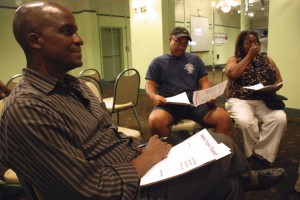Part I – Blog Post promotion
When tasked with promoting my question blog post – how public libraries are helping the job hunt – I immediately took to Twitter. Being a social media novice, this “promo” was my very first tweet. Prior to the post, I had two official followers (now I have a whopping five), so my expectations were low, to say the least.
After re-skimming Jessica Hische’s website on how Twitter actually works, I tagged the Queens Library in my tweet. Although the tweet wasn’t reposted or commented on, the library sent me a direct message regarding the post and became my third follower.

My second-ever Twitter interaction
So was the promotion successful? It didn’t solicit any new comments on the blog post itself, but all in all, I was pretty surprised that I got any Twitter responses, and at the end of the day I was pleased.
For the second promotion, I decided to skip Facebook (I was trying to save it for personal use, but that’s becoming increasingly difficult), and instead commented on another news article.
Earlier this week, the New York Daily News published an article about a new children’s area at the same library that my post covered earlier. Having explored the whole library while reporting, I gave my thoughts on the Discovery Children’s Zone (which is pretty impressive, even to a 25-year-old), and then slipped in a link to my blog at the end. As soon as I finalized my comment, I realized mistake number one: I definitely should have shortened the link with bit.ly. Oops. I tried to go back and edit, but apparently those comments are set in stone. Instead of re-posting a shortened link, I decided to cut my losses and promise to do better next time.
Again, how successful was this tactic? Not very. Although 37 people “liked” the Daily News Article so far, as of now, I’m the only person to have commented. And as far as I can tell, that comment didn’t solicit any new traffic to my blog.
Part II – Survey research
I found the second half of our social media homework far more challenging. For starters, I didn’t know where to – well – start.
Although I’m still getting to know Jamaica and the rest of CD 12, my experiences so far tell me that locals aren’t really taking to social media as quickly as other New Yorkers. I’ve found very few blogs, little Facebook activity, and Twitter use which seems to be limited to official organizations that tweet sporadically. For example, although the Jamaica, NY Facebook page has more than 15,000 “likes,” it has no wall to post on, and it hasn’t been tagged in anyone else’s posts since May.
Before turning to social media for preliminary ideas, I combed through notes from recent interviews that I conducted in the area. Of the many issues I’ve been talking about over the past few weeks, everything seems to lead back to public transportation. Given the high density of public transit in Jamaica, I was surprised to hear that many locals feel that the coverage is not extensive enough. Earlier this week, a career coach mentioned to me that the lack of public transportation is a huge impediment to employment. So that’s where I decided to start.
For preliminary research, I posted on both Twitter (twice) and Facebook (throwing my desire to save it for personal use out the window). Because we are supposed to be reporting on our CD, I addressed the questions to people living in the area. I don’t really have any friends or followers, however, in Jamaica on Twitter or Facebook. That’s definitely a problem that I need to work on from here on out. So, as I predicted, I didn’t get any responses on Twitter, and just one “like” on Facebook.

- Not sure what “liking” this question even means…
In an attempt to get at least one response, I posed the question again, this time using a hashtag. I also tried to broaden the question a bit, this time addressing it to anyone in Queens. It’s only been up for a few hours, but again, so far nothing has come of it yet.
To be honest, I find it challenging to use social media to do research for this particular assignment. Although I definitely understand its validity and can see how it would be useful in other circumstances, I struggle to find how it is applicable here. And while there is so much more to social media than just Twitter and Facebook, after reviewing my notes, I had a hard time figuring out how any other platforms could help me out. To solicit more insight, I could open up the question to anyone in general, but again, I’m unsure if that would be really valuable in reporting on Jamaica.















